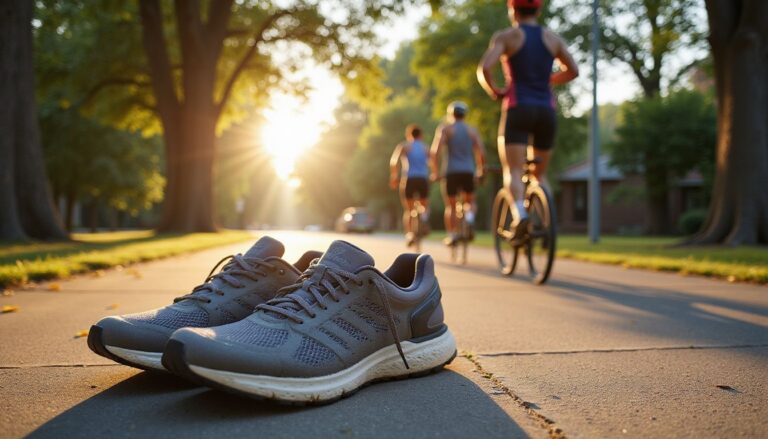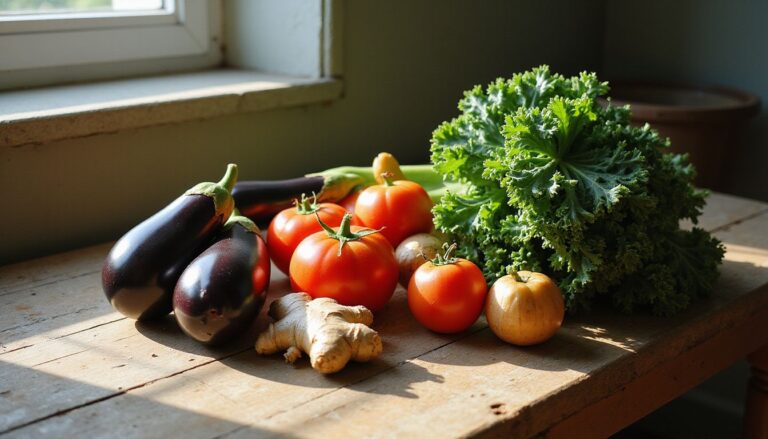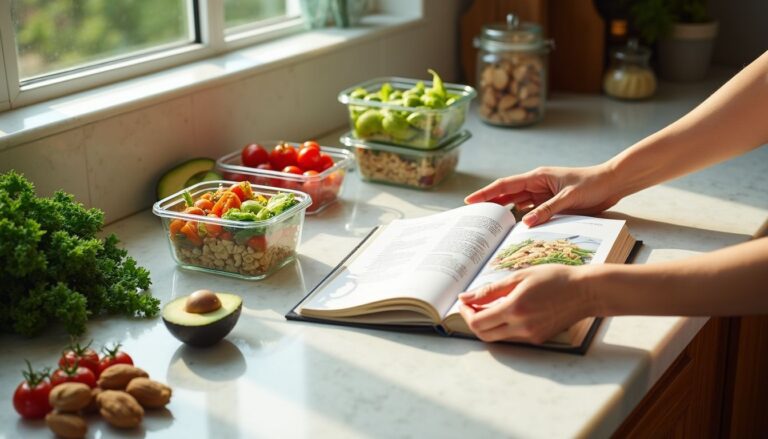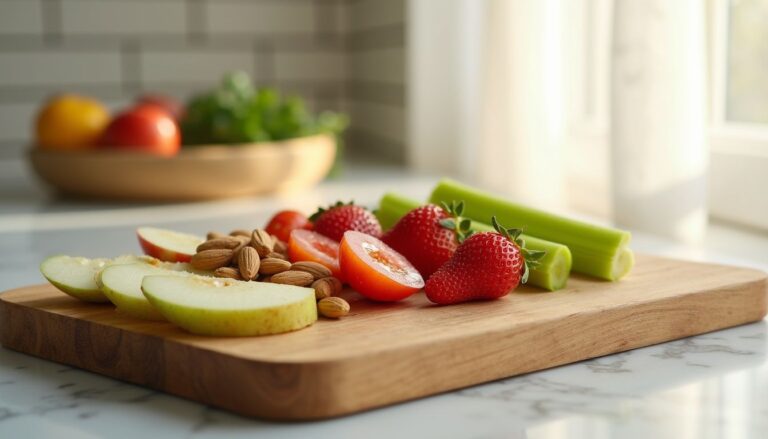Shehnaaz Gill Weight Loss Journey: Shedding 12 Kg In 6 Months
Our Nutrition Assistant AI Suite will transform your body. You will lose fat, get toned, and build muscle. Gain confidence and optimal health.
If you have struggled to lose weight or keep it off, you are not alone. The Shehnaaz Gill weight loss journey drew attention after she lost 12 kg in 6 months during the COVID-19 lockdown. This guide covers her diet plan, activity routine, and small daily habits you can use to reach a healthy weight safely.
Keep reading for clear steps you can try this week.
Key Takeaways
- Shehnaaz Gill lost 12 kg in six months during the 2020 lockdown with portion control, simple home meals, and regular walking.
- Her diet centered on balance, with protein-rich breakfasts like paneer or moong dal cheela, light snacks such as roasted makhana, and simple dinners like khichdi.
- She skipped fad diets and harsh workouts, focusing on moderation and routine. This aligns with research in the British Journal of Nutrition (2014) and the American Journal of Clinical Nutrition.
- Evidence from the CDC (2023) and Harvard T.H. Chan School of Public Health supports gradual weight loss from lifestyle changes over crash diets.
- Her approach highlights mindful eating, fewer processed foods, celebrating small milestones, and staying motivated by realistic goals.
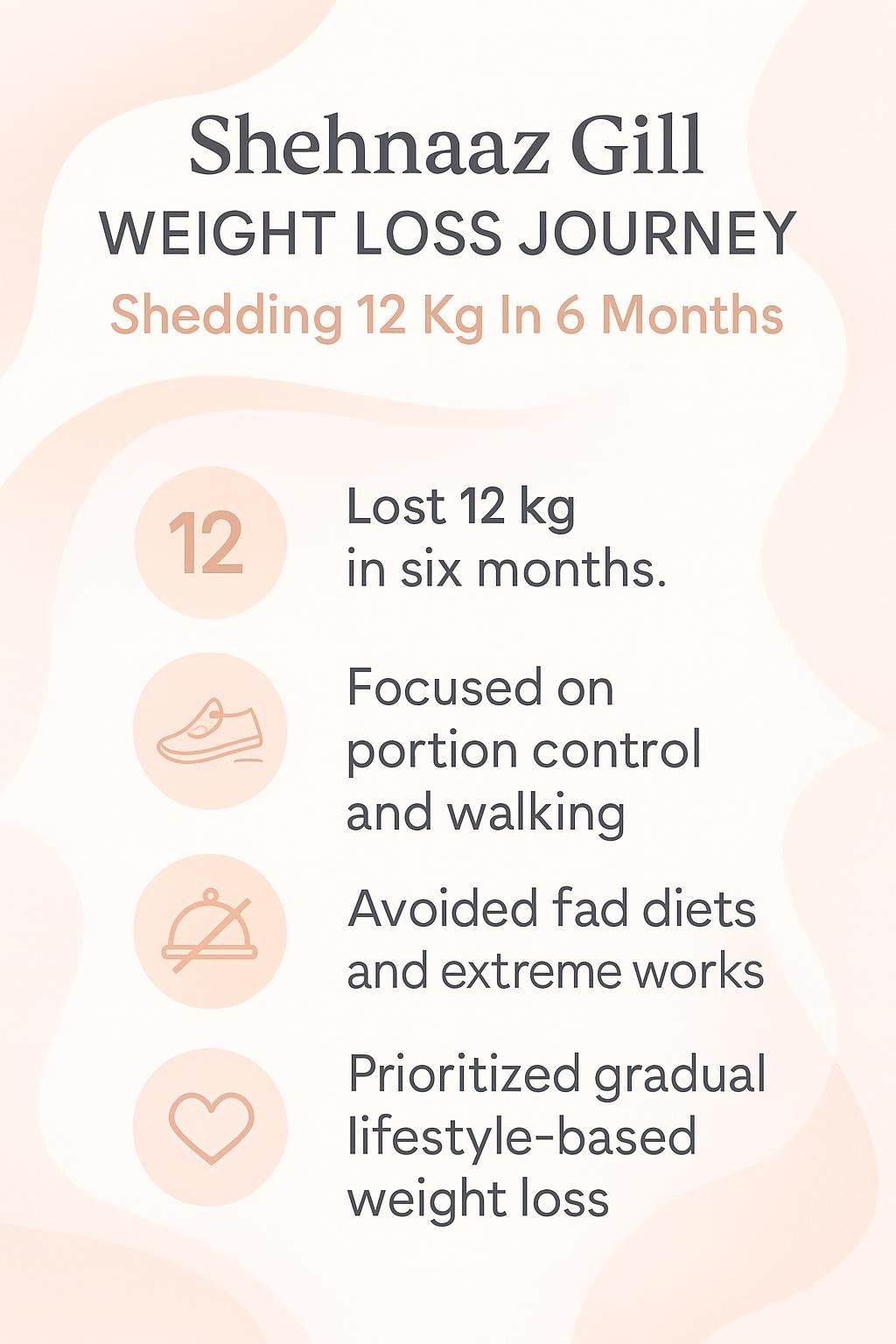
How Did Shehnaaz Gill Transform During Lockdown?

Lockdown gave Shehnaaz Gill space to focus on her health. After Bigg Boss 13 in 2020, she began reshaping her routine. Fans saw her progress on Instagram as her face and frame became leaner over time.
She lost 12 kg in 6 months by changing everyday habits. Meals were lighter and higher in dietary fiber, such as vegetables and sprouts salad. Fried snacks were swapped for fox nuts, also called makhana, or a simple apple bowl.
Shehnaaz explained her approach clearly.
I decided to eat less, eat simple home food, and be consistent. I did not touch fancy gym diets or harsh workouts.
Lunch and dinner shifted to moong dal, roti, khichdi, and salads. Fad diets were off the table. Her change shows how portion control and consistency can beat extreme dieting or punishing exercise plans.
Key Strategies Behind Shehnaaz Gill’s 12 Kg Weight Loss
Shehnaaz Gill reached her goal with simple changes to eating and daily routines. The methods are practical, easy to follow, and do not require special products.
How Did Portion Control Help in Her Weight Loss?
Portion control made a major difference. Shrinking serving sizes trims calories without cutting favorite foods like poha, khichdi, or soup. Smaller plates and measured servings help you build a steady calorie deficit while staying satisfied.
Skipping meals can backfire. Instead, eat regular meals in modest amounts and notice hunger and fullness signals. Stop when you feel satisfied, not stuffed.
Research in the British Journal of Nutrition links larger portions to higher calorie intake, which can stall long-term weight control.^1^ In many Indian households, fitness coaches and dietitians recommend smaller, balanced plates over banning whole food groups.
For example, choose one whole-wheat roti with mixed vegetables and mung bean curry at lunch. Avoid doubling rotis or serving large bowls of white rice. This keeps metabolism steady during the day and limits extra fat storage.
Many people find this method sustainable because no food is off limits, just right-sized.
^1 Rolls BJ et al., “Portion Size: Effects on Children’s Eating and Weight,” British Journal of Nutrition (2014).
Why Limiting Meal Variety Was Important for Her?
After reducing portions, Shehnaaz also narrowed meal choices. A big variety can invite overeating due to curiosity and taste fatigue. Fewer options lower decision stress and make it easier to stay consistent.
Repeating simple meals, like dosa at breakfast or khichdi at dinner, supports mindful eating and cuts the lure of high-calorie snacks and ultra-processed foods. This steady pattern helped her keep calories in check during lockdown.
How Did She Avoid Fad Diets and Extreme Workouts?
Limiting choice made it simpler to ignore trendy plans like crash diets or extreme detoxes. She built plates with protein, whole grains, vegetables, and familiar dishes such as dosa and khichdi. The goal was balance and patience, not quick fixes.
Movement stayed moderate too. Short walks, light stretching, and gentle activity replaced intense training. Evidence suggests that consistent activity plus a calorie deficit beats bursts of high-intensity training for long-term weight control [1].
Tip: Keep snacks like roasted makhana and fresh fruit handy to prevent trips to fried or sugary options.
You don’t have to punish your body with extreme measures to see change.
What Does Shehnaaz Gill’s Diet Plan Include?
Her daily plan was simple and structured. It used turmeric water, protein-rich breakfasts, balanced lunches, light snacks, and easy dinners like khichdi, which makes the routine easy to repeat.
Why Start the Day with Turmeric Water?
Many people begin the day with warm turmeric water. Turmeric contains curcumin, a natural compound with anti-inflammatory effects. Early research suggests curcumin may help with fat regulation and support metabolic health.
Add a pinch of turmeric and black pepper to warm water. The pepper improves curcumin absorption. This drink is low in calories and can help control morning cravings before breakfast.
What Are Protein-Rich Breakfast Options She Follows?
A protein-focused breakfast supports fullness and steady energy. Try these simple options.
- Paneer or tofu cubes for easy, high-quality protein, especially helpful for vegetarian plans.
- Two boiled or scrambled eggs, about 12 grams of protein, great for satiety.
- Greek yogurt or homemade curd with nuts for protein, calcium, and probiotics.
- Moong dal cheela or besan chilla, a savory pancake with plant protein.
- Granola mixed with Greek yogurt to add fiber and protein for digestion and fullness.
- Moong bean sprouts added to salads or sandwiches for vitamin C, iron, and plant protein.
- Milk-based smoothies with seasonal fruit. One cup of low-fat milk has about 8 grams of protein.
- Dosa made from a fermented batter of lentils and rice. Use a light drizzle of oil instead of ghee.
- Roasted fox nuts, known as makhana, a low-calorie, moderately protein-rich crunchy snack.
- Chia or flaxseeds on oats or toast for omega-3 fats and extra protein.
- Khichdi on some mornings for a comforting, balanced bowl of lentils and rice.
On busy days, a bowl of thick yogurt with a little granola kept me full until lunch.
How Are Midday Meals Balanced with Vegetables and Whole Grains?
Lunch should fuel your afternoon without a slump. Build your plate around vegetables, whole grains, and a steady protein.
- Fill half your plate with leafy greens or mixed vegetables for fiber and micronutrients.
- Use brown rice, whole-wheat roti, or quinoa for complex carbs and slower energy release.
- Cut down refined grains to stabilize blood sugar and appetite.
- Add pulses, lentils, or paneer to protect muscle while targeting a healthy weight, such as 55 kg if that fits your frame.
- Limit heavy sauces and keep oil modest to control calories.
- Season with simple spices instead of sugary, salty condiments.
- Eat slowly and stop when comfortably full.
- Choose water or warm turmeric water over sweetened drinks.
- Rotate vegetables like carrots, spinach, and cauliflower across the week.
- Keep the meal simple with a few dishes to support portion control.
Why Choose Fox Nuts (Makhana) for Evening Snacks?
Makhana, or fox nuts, is a light, crunchy choice that helps curb evening cravings. It is low in calories and supplies fiber along with minerals like magnesium and potassium.
Roast with a pinch of salt or mild spices. Compared with fried snacks, makhana supports portion control and helps you reach dinner without overeating.
What Makes Simple Dinners Like Khichdi Effective?
Khichdi is gentle, filling, and easy to portion. It combines rice, lentils, and mild spices for protein, fiber, and slow-digesting carbs.
This balance steadies hunger and reduces late-night snacking. High-fiber foods like lentils support gut health, which can help with weight control. With fewer ingredients, khichdi also prevents grazing on extras.
Many nutrition professionals and actors, such as Shilpa Shetty, favor simple dinners. If your target is 67 kg or another healthy weight, a calm, light dinner can make consistency easier.
What Are the Core Principles of Shehnaaz’s Weight Loss Diet?
Her diet rests on a few core ideas. Eat in moderation, stay consistent, and limit processed foods. These habits support steady progress and a better relationship with food.
How Does Focusing on Moderation Benefit Weight Loss?
Moderation protects you from rebound weight gain. You can enjoy favorite foods, including nuts, fruit, or an occasional dessert, without losing control of calories.
Smaller portions of balanced meals provide enough protein and fiber from vegetables, whole grains, fenugreek, and lean proteins. That mix reduces cravings and keeps energy stable across the day.
Research from Harvard T.H. Chan School of Public Health links moderate, steady habits with better long-term results than strict elimination plans.^1
^1 Harvard T.H. Chan School of Public Health: “Healthy Weight” (2023).
Why Is Consistency More Important Than Perfection?
Consistency builds results, even if every day is not perfect. Shehnaaz followed her plan for months, not weeks, and avoided shortcuts.
Missing a workout or enjoying a treat does not erase progress. What matters most is returning to your routine the next day. Studies show people who stick with routines are more likely to keep weight off [1].
Small steps repeated often beat rare, perfect days.
How Does Avoiding Processed Foods Help?
Processed foods often pack added sugar, salt, and unhealthy fats. They make it easy to overshoot your calorie needs without feeling full.
During #shehnaazgill’s journey, fresh vegetables, fruit, whole grains, and home-cooked meals took center stage. People who eat fewer ultra-processed foods usually take in more fiber and key nutrients, which supports weight control.^1^ A 2019 study found participants on unprocessed diets lost about two pounds in two weeks compared with those on ultra-processed diets.^2^
Choose real food most of the time. It is easier to understand portions and avoid hidden oils and sugars.
1. Monteiro CA et al., Public Health Nutr. 2018;21(1):5-17.
2. Hall KD et al., Cell Metab. 2019;30(1):67-77.e3.
How Does Shehnaaz Gill Approach Exercise?
Her exercise approach was simple. She moved daily in ways that felt natural and easy to maintain, which helped her stay consistent.
What Does Her Minimal Exercise Routine Look Like?
You do not need marathon workouts to see progress. Build a routine you can repeat.
- Walk briskly for 30 to 40 minutes most days. Walking raises calorie burn with low impact.
- Use light stretching or yoga to support mobility and reduce stiffness.
- Pick activities you enjoy, such as dancing at home, to stay motivated.
- Skip very strenuous training if it causes pain or frequent burnout.
- Add movement breaks, like taking the stairs or a post-meal stroll.
- Focus on doing something daily rather than going all out once a week.
- I kept workouts short and regular, and my energy improved within two weeks.
Why Emphasize Lifestyle Changes Over Intense Workouts?
Long-term weight control grows from daily habits. Research from the CDC points to steady movement, balanced meals, and sleep as the big drivers of lasting health.
Small choices add up, such as walking after dinner or standing more during the day. Most people find this approach easier to keep up than strictly scheduled high-intensity training.
What Are Sustainable Weight Management Tips from Shehnaaz Gill?
Shehnaaz Gill focused on realistic habits that you can maintain. These tips help you keep weight off and feel better overall.
How Can Mindful Eating Support Weight Loss?
Mindful eating means paying close attention to your food and your hunger cues. It reduces distraction and encourages you to stop when you are satisfied.
I tried placing my fork down between bites and chewing more slowly. Smaller portions kept me full longer. In one study, mindful eaters lost about four pounds more over four months than those who did not use this practice [1].
Turn off screens during meals and notice taste and texture. Slowing down can cut calories without strict rules.
…[1] Tapper K., Appetite, 2016
Why Is Gradual, Consistent Weight Loss Recommended?
A steady pace of one to two pounds per week is safer and more maintainable. Rapid weight loss often leads to regain and can reduce muscle, which slows metabolism.
Research from the CDC shows slow weight loss helps people keep the weight off. Set realistic weekly goals and protect your energy, mood, and nutrient intake while you make progress.
What Milestones and Motivations Shaped Her Weight Loss Journey?
Shehnaaz Gill set a clear plan to lose 12 kg in six months. She marked progress every two kilograms, using regular weigh-ins and progress photos for honest feedback.
Motivation came from improving health and self-image after reading unkind comments online. Each small win reinforced her belief that patience and consistency work.
What Can We Learn from Shehnaaz Gill’s Weight Loss Journey?
Her story shows that steady habits beat extreme plans. You can use the same tools: portion control, simple meals, mindful eating, and daily movement.
How Does Shehnaaz Gill’s Transformation Inspire Others?
Shehnaaz Gill’s transformation proves that small, repeatable actions can create big results. Many people feel encouraged when they see progress without strict diets or long workouts.
Set clear goals, then rely on consistency and moderation. That mindset lowers pressure and makes healthy choices feel doable.
What Simple Strategies Can Help Achieve Fitness Goals?
Practical steps make your plan easier to follow and track.
- Set specific goals, such as losing 2 pounds per week or walking 10,000 steps daily.
- Use a food diary or calorie app to spot patterns and adjust.
- Plan weekly menus to support portion control and reduce guesswork.
- Move daily with brisk walks or short home workouts for 20 to 30 minutes.
- Drink at least eight cups of water to manage appetite and stay hydrated.
- Center meals on vegetables, whole grains, lean proteins, and smart snacks like makhana.
- Limit processed foods and sugary drinks that can stall progress.
- Practice mindful eating to recognize real hunger and comfortable fullness.
- Stick with a consistent routine instead of chasing quick fixes.
- Celebrate small wins, like meeting your step goal, to build momentum.
Conclusion
Shehnaaz Gill’s weight loss shows how clear goals, portion control, balanced meals, and simple daily activity can lead to success. You do not need a fad diet or an extreme workout to lose weight.
Focus on progress, not perfection, and choose habits you can repeat. For medical conditions or special dietary needs, consult a qualified healthcare professional before making major changes.
FAQs
1. How did Shehnaaz Gill lose 12 kg in six months?
Shehnaaz Gill achieved her weight loss by following a calorie-controlled diet, increasing daily physical activity, and making consistent lifestyle changes. Reports show she focused on balanced meals with fewer processed foods and regular exercise routines.
2. What specific dietary changes did Shehnaaz Gill make during her weight loss journey?
Shehnaaz reduced sugar intake, limited fried foods, and increased the amount of fruits and vegetables in her meals. Data from nutrition experts suggest that such adjustments can help lower overall calorie consumption while providing essential nutrients.
3. Did Shehnaaz Gill use any special workout plan to shed weight?
Shehnaaz included simple exercises like brisk walking and home-based workouts rather than relying on intense gym sessions. Studies indicate that moderate but regular physical activity supports sustainable fat reduction over time.
4. Is it safe to lose 12 kg in six months as Shehnaaz Gill did?
Health professionals recommend losing one to two kilograms per month for lasting results. Evidence shows that gradual fat reduction lowers the risk of regaining lost mass and supports better health outcomes. Always consult a healthcare provider before starting any new fitness or nutrition plan.


